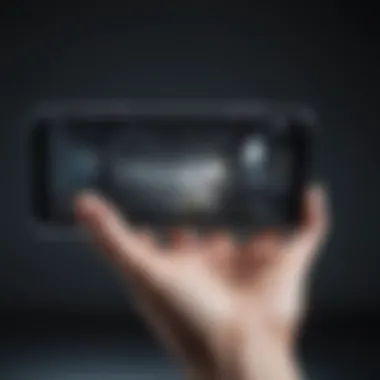Unveiling the Future: Smartphone Technology for Seeing Beyond Reality


Product Overview
Smartphones have undergone a paradigm shift with the revolutionary technology of seeing through objects. The concept involves utilizing smartphones as a tool to visually penetrate objects, offering a myriad of applications across various sectors. This article embarks on a journey to explore the disruptive nature of this innovation, its implications on industries, and the way we perceive and interact with the surrounding world.
Performance and User Experience
In the realm of this cutting-edge technology, performance benchmarks play a critical role. Users are keen on the responsiveness and accuracy of this feature. The user interface and software capabilities are paramount for seamless integration and intuitive operation. Gathering user experiences and feedback provides valuable insights to refine and enhance the overall user experience.
Comparison with Previous Models or Competitors
Advancements in this technology are significant as they build upon previous models. Competitive analysis with other similar products aids in understanding the distinct advantages and functionalities. Evaluating the value proposition is crucial to position this innovation in the market landscape effectively.
Tips and Tricks
Unlocking the full potential of this technology requires adept knowledge on how-to guides and tutorials. Discovering hidden features and functionalities adds a layer of intrigue to the user experience. Troubleshooting common issues ensures smooth operation and seamless integration into daily tasks.
Latest Updates and News
Stay informed about the latest developments in software updates and new features. Industry news and rumors surrounding upcoming products offer insights into the future trajectory of this innovation. Keep track of events and announcements from the forefront player in this domain to remain at the vanguard of technological advancements.
Introduction
Smartphones have evolved beyond mere communication devices into indispensable multi-functional tools, redefining how we perceive and interact with the world. The integration of advanced sensors and cameras has been a pivotal aspect of this evolution, allowing smartphones to offer a wide array of capabilities beyond traditional communication channels. In this article, we delve into the revolutionary concept of using smartphones to see through objects, exploring the profound impact of this technology on various industries and daily interactions.
Evolution of Smartphone Technology
From Communication Devices to Multi-Functional Tools
Smartphones have transitioned from being simple tools for communication to becoming versatile companions in our daily lives. The ability to perform tasks beyond making calls, such as accessing the internet, capturing high-quality photos, and even monitoring health parameters, showcases the significant evolution in smartphone technology. This shift towards multi-functionality has redefined user expectations and opened up a world of possibilities for technology integration.
Integration of Advanced Sensors and Cameras
The integration of advanced sensors and cameras stands out as one of the most impactful developments in smartphone technology. These components have enabled smartphones to offer features like AR capabilities, precise biometric authentication, and professional-grade photography options. The seamless integration of these sensors and cameras into compact devices highlights the impressive engineering feats that have become synonymous with modern smartphones, enhancing user experiences in diverse ways.
Emergence of Seeing Through Smartphones


Augmented Reality (AR) Development
Augmented Reality (AR) development has been a driving force behind the concept of seeing through smartphones. By superimposing digital information onto the physical world, AR technology has revolutionized gaming, navigation, and educational experiences. The ability to interact with virtual elements in real-time has captivated users and expanded the possibilities of smartphone functionality.
Enhanced Camera Capabilities
Enhanced camera capabilities have played a crucial role in enabling smartphones to see through objects effectively. The advancements in camera technology, including improved sensors, focal lengths, and image processing algorithms, have elevated smartphone photography to professional levels. From depth-sensing for AR applications to low-light performance for night photography, enhanced camera capabilities have become a cornerstone of the smartphone user experience.
Technological Advancements
Depth Sensing Technology
Principle of Operation
In understanding the intricate workings of Depth Sensing Technology, we unravel a fundamental aspect crucial to our exploration of seeing through smartphones. The principle of operation revolves around the device's ability to measure distances accurately by determining the time it takes for emitted light to bounce back to the sensor. This unique characteristic of precise distance calculation forms the backbone of enabling augmented reality experiences and refining photography functionalities on smartphones. Despite its complexities, the unparalleled accuracy in depth detection stands as a distinctive advantage, offering users a new dimension of engagement. However, challenges such as computational requirements and potential inaccuracies warrant careful consideration for its integration within the scope of this revolutionary technology.
Applications in AR and Photography
Delving deeper into the applications of Depth Sensing Technology in augmented reality (AR) and photography unveils a realm of endless possibilities. By harnessing this technology, smartphones can recreate three-dimensional environments with remarkable realism in AR applications. Moreover, in the realm of photography, the incorporation of depth sensing elevates image quality by enabling features like sophisticated background blurring and enhanced subject focus. This unique feature set not only enhances user experience but also opens doors to innovative imaging techniques. Yet, while the benefits are pronounced, challenges such as limited compatibility with certain devices and processing overheads must be carefully navigated to maximize the utility of these applications within the narrative of smartphone vision.
Li
DAR Technology Integration
Enhancing Spatial Awareness
The integration of Li DAR technology in smartphones marks a pivotal advancement in enhancing spatial awareness. By utilizing laser pulses to gauge distances, this technology offers unparalleled precision in mapping physical spaces, thereby refining the user's spatial perception through their smartphones. The key characteristic of LiDAR lies in its ability to capture detailed depth information swiftly and accurately, making it a popular choice for applications demanding real-time spatial data. However, navigating the intricacies of LiDAR integration within the context of this revolutionary technology requires a strategic consideration of its benefits and limitations.
Impact on Virtual Reality (VR)
Exploring the impact of Li DAR technology on virtual reality (VR) unlocks a realm of immersive experiences redefined by spatial precision. The key characteristic of LiDAR's contribution to VR lies in its ability to create lifelike virtual environments by accurately mapping physical spaces into the digital realm. This advancement not only enhances the user's VR encounters but also sets a new standard for realism and interaction within virtual settings. Yet, the unique feature of LiDAR technology brings forth considerations such as potential limitations in certain lighting conditions and the need for compatible software ecosystems, shaping its advantages and challenges within the expansive landscape of smartphone-enabled vision.
Applications in Different Industries
Smartphones are not just communication devices but have evolved into indispensable multifunctional tools that are reshaping various sectors.
The applications of smartphones in different industries hold profound significance in revolutionizing day-to-day operations and enhancing efficiency. From the medical field to automotive sectors, the integration of cutting-edge technology is driving unprecedented advancements. The ability to visualize objects through smartphones has opened doors to a myriad of possibilities, transforming traditional processes into streamlined digital experiences. This article delves into the transformative impact of smartphone technology across diverse sectors and explores the innovative applications that are reshaping industries globally.


Medical Field
Diagnostic Imaging Advancements
Diagnostic imaging advancements have revolutionized the field of medicine by providing accurate and detailed insights into the human body. Leveraging smartphone technology for diagnostic imaging has significantly enhanced the efficiency of medical professionals in diagnosing conditions and formulating treatment plans. The key characteristic of diagnostic imaging advancements lies in their ability to capture high-resolution images in real-time, facilitating prompt and precise medical interventions. This feature is instrumental in improving diagnostic accuracy and patient outcomes, making it a valuable asset in the medical field. However, the increasing reliance on diagnostic imaging may raise concerns regarding overutilization and radiation exposure, necessitating a balanced approach in its utilization.
Surgical Navigation Systems
Surgical navigation systems represent a groundbreaking advancement in surgical procedures, enabling surgeons to perform intricate operations with unprecedented precision. By incorporating smartphone-driven navigation systems, surgical procedures have become more accurate and minimally invasive. The unique feature of surgical navigation systems lies in their ability to provide real-time guidance during surgeries, enhancing the surgeon's spatial orientation and improving surgical outcomes. While these systems offer unparalleled assistance to surgeons, they may introduce challenges related to device integration and training requirements. Despite these considerations, surgical navigation systems have significantly contributed to enhancing surgical precision and patient safety.
Construction and Architecture
Virtual Building Tours
Virtual building tours have emerged as a transformative tool in the field of construction and architecture, offering stakeholders immersive experiences of architectural designs. Through smartphone-compatible virtual tours, stakeholders can explore construction projects in a virtual environment, gaining valuable insights into spatial layouts and design aesthetics. The key characteristic of virtual building tours is their ability to provide interactive and dynamic visualization of architectural plans, aiding in client presentations and project evaluations. This feature ensures improved communication among project teams and clients, streamlining decision-making processes. However, the reliance on virtual tours may limit physical site inspections and tactile assessments, requiring a balance between virtual and physical evaluations.
Blueprint Overlay for Construction
Blueprint overlay for construction aligns smartphone technology with architectural planning, facilitating enhanced project management and execution. By overlaying blueprints onto physical construction sites through smartphones, stakeholders can effectively assess design accuracies and construction progress. The unique feature of blueprint overlay lies in its ability to integrate digital blueprints with real-world construction environments, enabling stakeholders to visualize design concepts in practical settings. This integration improves construction efficiencies and reduces errors by providing real-time comparisons between digital designs and physical structures. However, challenges related to data synchronization and device compatibility may arise, necessitating robust technical support and training initiatives.
Automotive Sector
Augmented HUD Displays
Augmented Head-Up Display (HUD) systems have revolutionized the driving experience by integrating smartphone technology with vehicle dashboards. These systems project essential driving information onto the windshield, enhancing driver awareness and safety. The key characteristic of augmented HUD displays is their ability to overlay navigation prompts, vehicle speed, and safety warnings directly in the driver's line of sight, reducing distractions and improving reaction times. This feature significantly enhances driving convenience and mitigates the risks associated with diverted attention. While augmented HUD displays offer unparalleled convenience, concerns regarding information overload and display visibility in varying conditions may pose challenges, necessitating continuous refinements for optimal user experience.
Enhanced Driver Assistance Systems
Enhanced Driver Assistance Systems (ADAS) leverage smartphone sensors and AI algorithms to provide advanced safety features for vehicles. These systems offer functionalities such as lane departure warnings, collision avoidance, and adaptive cruise control, enhancing overall driving safety. The unique feature of ADAS lies in its capability to analyze real-time data from smartphone sensors and cameras, offering proactive assistance to drivers in various situations. This capability improves driving precision and reduces the likelihood of accidents, making it a valuable asset in the automotive sector. However, considerations regarding data privacy and system reliability may influence the widespread adoption of enhanced driver assistance systems, emphasizing the need for robust security measures and continuous technological advancements.
Challenges and Limitations
Privacy Concerns
Data Security Issues


Zooming in on the realm of data security issues within the context of utilizing smartphones for perceiving beyond physical obstacles opens up a realm of exploration into safeguarding sensitive information. This particular facet accentuates the critical importance of protecting user data from breaches and unauthorized access. By delving into the intricate nuances of data security, it grounds us in the realm of digital protection, where encryption, authentication mechanisms, and secure storage methodologies stand tall as fortresses against potential cyber threats. Understanding the distinctive characteristics and functionalities of data security issues allows us to fortify the foundations upon which this innovative technology stands, heightening trust and reliability within the digital landscape.
Regulatory Compliance Challenges
Unveiling the intricacies of regulatory compliance challenges within the realm of groundbreaking smartphone technology mandates a nuanced approach towards adhering to established frameworks and guidelines. The dynamic nature of regulatory standards necessitates a vigilant stance to ensure alignment with legal requirements and industry-specific regulations. By dissecting the complexities of regulatory compliance challenges, we gain a comprehensive insight into the landscape of legal obligations and ethical considerations that underpin the responsible deployment of this advanced technological paradigm. An exploration of the unique contours of regulatory compliance challenges presents us with a holistic view of the interplay between innovation and regulatory integrity, paving the way for sustainable growth and responsible technological advancements.
Technical Constraints
Amid the frontier of technical constraints surrounding the progressive integration of seeing through smartphones, a terrain marked by the intersection of computational capabilities and ecosystem dynamics unfolds. Understanding the intricacies of these limitations offers a gateway to optimizing performance and enhancing user experience within the realm of groundbreaking technological advancements.
Processing Power Requirements
Delving into the realm of processing power requirements illuminates the critical role that computational strength plays in enabling seamless and efficient operation of this visionary technology. The nuanced balance between processing power and energy efficiency emerges as a focal point, dictating the efficacy and optimization of tasks performed through smartphones' visual penetration capabilities. By dissecting the unique features and functionalities of processing power requirements, we glean insights into the intricacies of computational demands, paving the way for enhanced performance metrics and operational fluidity.
Integration with Existing Ecosystems
Exploring the complexities surrounding integration with existing ecosystems within the realm of smartphone-based vision enhancement unravels a tapestry of connectivity and interoperability challenges. The seamless alignment of this revolutionary technology with established digital frameworks necessitates a comprehensive understanding of compatibility requirements and integration protocols. By navigating through the distinct features and nuances of integrating this groundbreaking technology with existing ecosystems, we embark on a journey towards harmonizing innovation with continuity in a dynamic digital environment, fostering synergistic growth and transformative technological evolution.
Future Prospects
In the realm of groundbreaking technological advancements on smartphones, exploring the future prospects undoubtedly holds significant importance. The evolution from mere communication devices to sophisticated tools that enable us to see through objects paves the way for a myriad of possibilities yet to be fully realized. By delving deeper into what lies ahead, we can anticipate a seamless integration of AI in enhancing user experiences. The trajectory for smartphones to not only visualize the world around us but also comprehend and interact intelligently with it through AI is a fascinating prospect that shapes the landscape of technology.
Advancements in AI Integration
Machine Learning Algorithms for Object Recognition
A pivotal aspect of this integration is the utilization of Machine Learning Algorithms for Object Recognition. These algorithms play a vital role in enabling smartphones to not just perceive the environment but also comprehend and interpret the objects within it. The key characteristic that distinguishes Machine Learning Algorithms is their ability to adapt and improve based on patterns and data, enhancing the accuracy and efficiency of object recognition. In the context of this article, Machine Learning Algorithms offer a robust solution for enhancing the visual capabilities of smartphones, thereby propelling the concept of seeing through smartphones to new heights.
Real-time Data Processing Capabilities
Another significant element in AI integration is the Real-time Data Processing Capabilities that smartphones can leverage. By enabling devices to process data instantaneously, this feature accelerates the speed and responsiveness of tasks related to visual recognition and interpretation. The pivotal characteristic of real-time processing is its ability to deliver immediate results, ensuring swift and accurate responses to user interactions. While this capability enhances the overall user experience, it also poses challenges in terms of resource consumption and balancing computational efficiency. However, its contribution to enabling smartphones to see through objects efficiently cannot be understated.
Expansion of Use Cases
Innovative Applications in Entertainment
Diving into the realm of entertainment, innovative applications fueled by smartphone visual technologies are reshaping how we engage with digital content. The key characteristic of these applications lies in their ability to blur the boundaries between the physical and digital worlds, offering immersive experiences like never before. By leveraging the interactive capabilities of smartphones, entertainment avenues are expanding into uncharted territories, opening up a realm of possibilities for both creators and consumers. While this evolution enhances engagement and entertainment value, it also introduces considerations regarding data privacy and user consent.
Integration with Io
T Devices ####
In the realm of Io T, the integration of smartphones holds immense potential for streamlining daily processes and enhancing connectivity. The key characteristic of this integration is its ability to create a seamless network of smart devices that can communicate and collaborate effectively. By bridging the gap between smartphone visual capabilities and IoT functionalities, users can experience a holistic and interconnected environment where automation and control are at their fingertips. However, this integration presents challenges in terms of interoperability and data security, requiring robust measures to ensure a harmonious and secure ecosystem. Despite these challenges, the integration of smartphones with IoT devices heralds a future where convenience and efficiency converge seamlessly.



